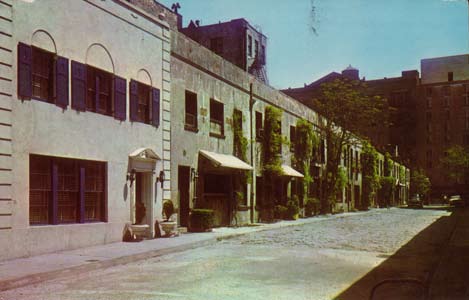Greenwich Village is one of New York City’s most eclectic neighborhoods. Everything that makes New York famous can be found in this 185-acre plot. There are Off-Broadway theaters, parks, pubs, and a vibrant university life for New York University students and faculty.
The architecture and design span every era New York City has been a part of, even during its earliest days. In fact, the neighborhood is home to one highly coveted gated community. The street, and the houses on it, date back to 1801 and remain important landmarks to the city and to the people living there. This community is known as Washington Mews, and it’s been a haven for arts and education for centuries.
On June 5th 1801, prominent sea captain, Robert Richard Randell, died in his New City home. With large amounts of land and a philanthropic heart, Randell bequeathed the farm that would become Washington Mews to an institution called Sailors’ Snug Harbor. Randell requested that, in exchange for the land, the organization build a house for elderly and destitute sailors unable to work. To gain funding for this project, Sailors’ Snug Harbor leased the land to wealthy patrons, building the large stable houses along the cobble stone streets that can still be seen today. Eventually, enough money was raised for the sailor boarding house, though it was built in Staten Island, instead of in the Mews.
Sailors’ Snug Harbor controlled the land throughout the 1800’s. For most of the century, the north side of the street were horse stables, while the south side were residencies. Eventually, the city began going through major changes, and a gate was erected in 1881 to help distinguish the privately owned Mews from the rest of the city. While it might seem as though New York was trying to hide this relic of the past, it only made the street more intriguing to potential residents. In 1916, Sailors’ Snug Harbor decided to indulge this interest by converting the northern stables and southern homes into artist residences, leaving the original facades of the homes intact. After this remodel was completed, some of New York’s best and brightest made their homes in the Mews, like novelist John Dos Passos and Gertrude Vanderbilt Whitney.
The street was sold to New York University in 1950 and has been used as offices and faculty housing ever since. Sadly, if you’re seeking to live there, you need to be connected to the school. Even then, there’s a waiting list. So, while the average buyer isn’t very likely to buy a house there, the gates are always open and there are plenty of other homes for sale in the neighborhood. To walk down the Washington Mews is to walk through time. It’s a trip to the very beginnings of New York City, before the grid and skyscrapers dominated the area. While always home to affluent members of society, the humble beginnings of the Mews are ever present and preserved.
Andrew Berman, executive director of the Greenwich Village Society for Historic Preservation, has stated, “It’s an icon of the neighborhood…that captures the magic of a place like Greenwich Village.” The people who live in the area aggressively agree with Berman. The GVSHP is often responsible for fielding dozens of calls if there’s ever even a rumor of change happening to the street. The Mews is protected by a small, but mighty army of those who believe in preserving the history of the city.
Greenwich Village has everything a New Yorker could want in a neighborhood. The people are friendly, the culture is ever present, and the history is abundant. All too often, historical sights are demolished in favor of new, shiny buildings seeking to make their mark on the skyline. To preserve a historical sight in the city takes a tremendous amount of work and support. People need to be passionate about the places and histories they protect. Luckily, for the Washington Mews, this passion is forever on full display. The sleepy little street has made its mark on the city, on Greenwich Village, and in the hearts of New Yorkers. The Mews aren’t going anywhere, so head down to Washington Square Park, walk up 5th avenue one block, and take a trip to the past.
Russell is a writer and comic based in New York City. His plays have been featured at Penn State’s Cultural Conversation’s Festival, The NYC Thespis Festival, and Imaginarium’s Inaugural Theater Festival. Follow him on TikTok and Instagram @pooleparty528



